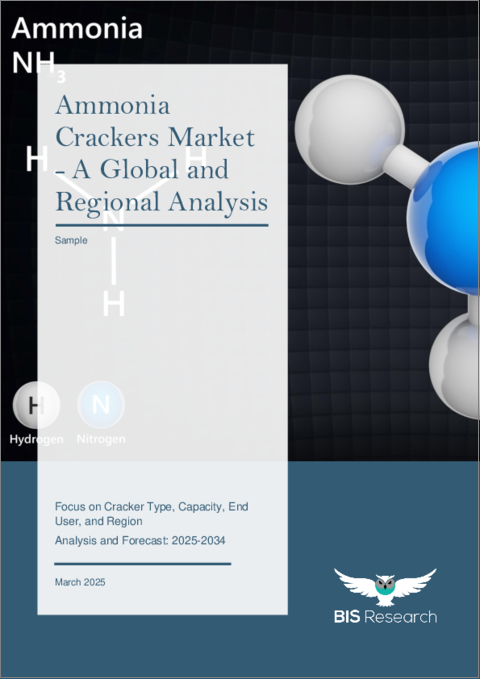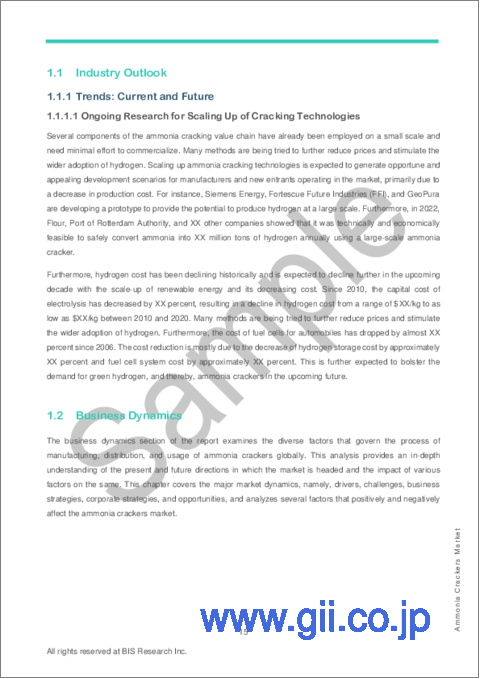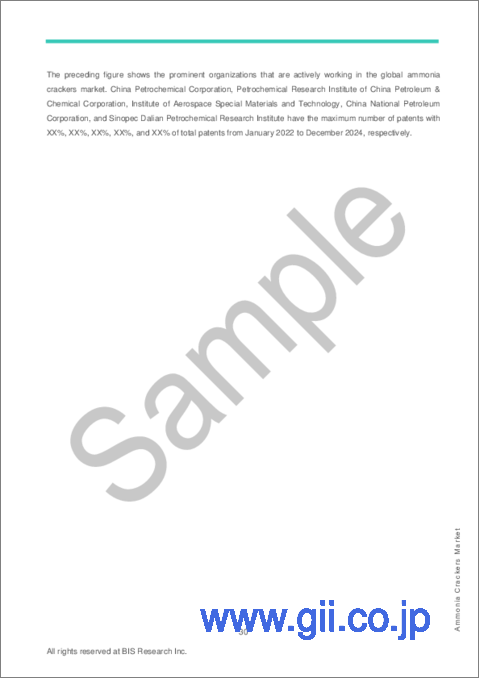|
|
市場調査レポート
商品コード
1682228
アンモニアクラッカー市場- 世界および地域別分析:クラッカータイプ別、容量別、エンドユーザー別、地域別 - 分析と予測(2025年~2034年)Ammonia Crackers Market - A Global and Regional Analysis: Focus on Cracker Type, Capacity, End User, and Region - Analysis and Forecast, 2025-2034 |
||||||
カスタマイズ可能
|
|||||||
| アンモニアクラッカー市場- 世界および地域別分析:クラッカータイプ別、容量別、エンドユーザー別、地域別 - 分析と予測(2025年~2034年) |
|
出版日: 2025年03月20日
発行: BIS Research
ページ情報: 英文 120 Pages
納期: 1~5営業日
|
全表示
- 概要
- 目次
水素およびアンモニアなどの水素化合物は、グリーン転換において重要な役割を果たし、天然ガスに取って代わり、持続可能な未来を支えます。
さらに、水素は高圧に圧縮したり液化したりしても体積密度が低いため、輸送や産業用途を含む様々な用途で経済的に実行可能なエネルギーベクトルとして利用しやすいです。特殊な輸送インフラを最小限に抑えることで、水素は供給され利用される場所の近くで生成されます。さらに、水素から製造された合成燃料は、既存のインフラで使用することができるが、拡張する必要があるかもしれません。この課題を克服するため、液体状のアンモニアのような様々な水素キャリアは、炭素を含まず、容易に配給可能な水素キャリアであり、大量のエネルギーをコスト効率よく貯蔵・配給することを可能にします。さらに、国際エネルギー協会(IEA)によれば、地域によっては、アンモニアの形で水素を輸入する方が、水素として輸送するよりもコストが低いです。アンモニアの生産、取り扱い方法、サプライチェーンは成熟し、確立されていますが、純粋な水素を生成できる効率的なアンモニア分解技術はまだ発展途上であるため、アンモニアから水素を回収する効率的なプロセスを開発しなければなりません。
小規模アンモニアクラッカーは成熟段階にあり、大規模アンモニアクラッカーは開発段階にあります。アンモニアクラッカー市場のエコシステムは、一次アンモニアクラッカー製造業者、グリーン水素・グリーンアンモニア製造業者、技術プロバイダー、エンドユーザーで構成されます。市場はまだ発展途上であり、アジア太平洋地域と欧州が最前線で、北米、中国、世界のその他の地域、英国がそれに続きます。
水素製造用アンモニアクラッカーは、カーボンニュートラルなエネルギー部門の実現に向けた重要な一歩です。この技術を活用することで、化石燃料への依存度を減らすことができます。また、気候変動の影響を緩和し、よりクリーンで持続可能なエネルギー環境を促進することができます。研究開発が進むにつれて、アンモニアクラッカーは水素の生産、流通、利用の方法に革命をもたらし、より環境に優しく豊かな未来への新たな可能性を切り開く可能性を秘めています。
アンモニアクラッカーの使用が予想される主な地域は、アジア太平洋と日本、欧州です。世界的には、アンモニアクラッカーのメーカー、技術プロバイダー、エンドユーザーの間で数多くの提携が行われています。
当レポートでは、世界のアンモニアクラッカー市場について調査し、市場の概要とともに、クラッカータイプ別、容量別、エンドユーザー別、地域別の動向、および市場に参入する企業のプロファイルなどを提供しています。
目次
エグゼクティブサマリー
第1章 市場:業界の展望
- 動向:現在および将来の影響評価
- ステークホルダー分析
- 市場力学の概要
- 特許分析
- スタートアップの情勢
- 平均価格分析:世界および地域レベル、アンモニアクラッカー
- コストの内訳- アンモニアクラッカー
- コスト比較- 輸送距離に基づく集中型と分散型のアンモニアクラッカー
- バリューチェーン分析
- サプライチェーン分析
- 業界の魅力
- 世界のアンモニア生産、需要、貿易分析
- グリーンエネルギー移行と水素経済の影響
- 今後の展望
- グリーン水素市場のスナップショット
- グリーンアンモニア市場のスナップショット
第2章 アンモニアクラッカー市場(用途別)
- 用途のセグメンテーション
- 用途のサマリー
- アンモニアクラッカー市場(エンドユーザー別)
第3章 アンモニアクラッカー市場(製品別)
- 製品セグメンテーション
- 製品のサマリー
- アンモニアクラッカー市場(クラッカータイプ別)
- アンモニアクラッカー市場(容量別)
第4章 アンモニアクラッカー市場(地域別)
- アンモニアクラッカー市場(地域別)
- 北米
- 欧州
- アジア太平洋
- その他の地域
第5章 市場-競合ベンチマーキングと企業プロファイル
- 今後の見通し
- 地理的評価
- 企業プロファイル
- Haldor Topsoe A/S
- Siemens Energy
- KBR Inc
- Air Liquide
- thyssenkrupp AG
- Duiker Combustion Engineers
- AMMPOWER
- Lindberg/MPH
- Gasbarre Products, Inc.
- Suzhou Since Gas Technology Co., Ltd.
- Borel Swiss
- Nuberg GPD
- AMOGY Inc
- MVS Engineering Pvt. Ltd.
- Thermal Dynamix - A Judd Service Company
第6章 調査手法
Ammonia Crackers Market: Industry Overview
Hydrogen and hydrogen compounds such as ammonia play a key role in green transition, replace natural gas, and support a sustainable future. Moreover, hydrogen facilitates use as an economically viable energy vector in various applications, including transport and industrial applications, owing to its low volumetric density even when compressed to high pressures or liquefied. With minimal specialized transport infrastructure, hydrogen has been created close to where it is delivered and utilized. Moreover, synthetic fuels produced from hydrogen can be used in existing infrastructure, though they might need to be expanded. To overcome this challenge, various hydrogen carriers, such as ammonia in liquid form, are carbon-free and readily dispatchable hydrogen carriers, allowing the cost-effective storage and distribution of large quantities of energy. Furthermore, according to the International Energy Association (IEA), in some regions, the cost of imported hydrogen in the form of ammonia is lower than transporting it as hydrogen. Although ammonia production, handling practices, and supply chains are mature and well-established, efficient processes for the recovery of hydrogen from ammonia must be developed, as efficient ammonia cracking technologies that can generate pure hydrogen remain in their infancy.
Market Lifecycle Stage
The small-scale ammonia crackers are in their mature stage, while large-scale ammonia crackers are in their developing stage. The ecosystem of the ammonia crackers market comprises primary ammonia crackers manufacturers, green hydrogen and green ammonia producers, technology providers, and end users. The market is still developing, with Asia-Pacific and Europe at the forefront, followed by other regions such as North America, China, Rest-of-the-World, and the U.K.
Industrial Impact
- The ammonia crackers for hydrogen production represent a significant step toward achieving a carbon-neutral energy sector. By leveraging this technology, the reliance on fossil fuels can be reduced. It can also mitigate climate change impacts and promote a cleaner and more sustainable energy landscape. As research and development efforts continue to advance, ammonia crackers have the potential to revolutionize the way of hydrogen production, distribution, and utilization, unlocking new possibilities for a greener and more prosperous future.
- The major regions anticipated to use ammonia crackers are Asia-Pacific and Japan and Europe. Globally, there are numerous partnerships between manufacturers, technology providers, and end users of ammonia crackers.
Market Segmentation:
Segmentation 1: by End User
- Heat Treatment
- Metal Industry
- Oil and Gas
- Power Generation
- Mobility
- Others
Based on end user, the ammonia crackers market was led by the metal industry segment in 2024.
Segmentation 2: by Cracker Type
- Centralized
- Decentralized
Based on cracker type, the ammonia crackers market is estimated to be led by the decentralized segment during the forecast period of 2025-2034.
Segmentation 3: by Capacity
- Small Scale (<250 Nm3/hr)
- Medium Scale (250-1,000 Nm3/hr)
- Large Scale (>1,000 Nm3/hr)
Based on capacity, the ammonia crackers market was led by the small scale segment in 2024.
Segmentation 4: by Region
- North America - U.S., Canada, and Mexico
- Europe - Germany, U.K., France, Italy, Spain, Russia, and Rest-of-Europe
- Asia-Pacific- China, Japan, India, South Korea, and Rest-of-Asia-Pacific and Japan
- Rest-of-the-World - Middle East and Africa and South America
In the global ammonia crackers market, Asia-Pacific and Japan and Europe are anticipated to gain traction in terms of ammonia crackers' production, owing to the increased import of green ammonia as a hydrogen carrier in the regions.
Recent Developments in Ammonia Crackers Market
- In April 2021, Uniper undertook the initiative "Green Wilhelmshaven" with the intention of creating a prominent hydrogen hub in Wilhelmshaven, Germany. To support this endeavor, the company is currently engaged in developing a feasibility study. As part of the plan, Uniper intends to construct an import terminal dedicated to green ammonia. The proposed terminal will feature an "ammonia cracker" designed for the production of green hydrogen. Additionally, the terminal will be seamlessly integrated into the envisaged hydrogen network.
- In June 2023, Proton Ventures undertook diverse studies related to ammonia cracking on behalf of clients and maintains engagement in multiple research consortia. Centralized ammonia cracker solutions, designed for pure hydrogen production, exhibit functional parallels with natural gas processing plants utilized for hydrogen production. Apart from this, efforts are underway to develop decentralized ammonia cracker solutions, which do not invariably necessitate complete conversion and purification of hydrogen. This approach enhances system energy efficiency and cost-effectiveness. The upcoming objective entails the construction of a commercial pilot for ammonia cracking. This represents a critical intermediate phase in the industry's progression toward establishing hydrogen production facilities on a global scale. Proton Ventures conducted a comprehensive front-end engineering and design (FEED) study for a renewable ammonia facility in a closely coordinated effort with Switzerland's Casale S.A.
- In December 2021, Novatek and Uniper entered into a term sheet agreement outlining the provisions for the extended supply of substantial quantities of low-carbon ammonia. This supply arrangement is intended to serve Uniper's markets in both Germany and North-West Europe. Uniper is in the process of planning an ammonia import terminal situated in Wilhelmshaven. This facility is envisioned to encompass a storage infrastructure alongside a cracker that operates using green power sources.
- In September 2022, Syzygy Plasmonics, LOTTE Chemical, LOTTE Fine Chemical, and Sumitomo Corporation of Americas collaboratively announced their partnership to implement and test Syzygy's fully electric, photocatalytic ammonia cracking reactor on a commercial scale. The reactor is set to be installed and operationalized in the latter part of 2023 at LOTTE Chemical's site in Ulsan, South Korea.
Demand - Drivers and Limitations
The following are the demand drivers for the ammonia crackers market:
- Increasing Awareness Regarding Green Hydrogen
- Increased Adoption of Ammonia Crackers in End-User Industries
- Need for Effective Hydrogen Carrier
The market is expected to face some limitations due to the following challenges:
- Toxicity of Liquid Ammonia and Trace Amounts of Ammonia in Hydrogen after Decomposition
- High Cost of Green Hydrogen Production and Requirement of Significant Amount of Energy in Cracking
How can this report add value to an organization?
Product/Innovation Strategy: The product segment helps the reader understand the different cracker types and capacities involved in the ammonia crackers market. The cracker type segment has been segmented into centralized and decentralized. The capacity segment has been segmented into small scale (<250 Nm3/hr), medium scale (250-1,000 Nm3/hr) and large scale (>1,000 Nm3/hr). Moreover, the study provides the reader with a detailed understanding of the ammonia crackers market based on end user, including heat treatment, metal industry, oil and gas, power generation, mobility, and others. The increasing adoption of ammonia crackers in power generation and mobility sectors is expected to fuel market growth in the future.
Growth/Marketing Strategy: The ammonia crackers market has seen major development by key players operating in the market, such as business expansions, partnerships, collaborations, mergers and acquisitions, and joint ventures. The favored strategy for the companies has been business partnerships to strengthen their position in the ammonia crackers market. For instance, in January 2023, thyssenkrupp AG and ADNOC signed a memorandum of understanding (MoU) to explore a long-term partnership to create new markets for hydrogen and promote global clean energy value chains. The agreement focuses on a joint project development of large-scale ammonia cracking, which is used to extract hydrogen from ammonia after transportation.
Competitive Strategy: Key players in the ammonia crackers market analyzed and profiled in the study involve ammonia cracker producers and the overall ecosystem. Moreover, a detailed competitive benchmarking of the players operating in the ammonia crackers market has been done to help the reader understand how players stack against each other, presenting a clear market landscape. Additionally, comprehensive competitive strategies such as partnerships, agreements, acquisitions, and collaborations will aid the reader in understanding the untapped revenue pockets in the market.
Key Market Players and Competition Synopsis
Ammonia has already established itself as a well-developed method for storing hydrogen. Storage tanks designed for liquefied petroleum gas (LPG) that share similarities in design and function with ammonia tanks have been successfully built, capable of accommodating capacities up to 130,000 m3. To put it into perspective, a single tank of this magnitude could store approximately 0.5 terawatt-hours (TWh) of liquid ammonia. This storage solution is not constrained by geographical limitations and can be conveniently expanded in a modular manner wherever necessary. Ammonia crackers play a key role in end-user industries, including the metal industry, heat treatment, power generation, mobility, oil and gas, and others. In 2022, the metal industry led the global ammonia crackers market; however, power generation and mobility industries are expected to gain traction over the forecast period with increased installation of large-scale ammonia crackers.
Some of the prominent producers of ammonia crackers are:
Company Type 1 (by Capacity): Small Scale (<250 Nm3/hr)
- Lindberg/MPH
- Borel Swiss
- Gasbarre Products, Inc.
- Since Gas
- Nuberg GPD
- MVS Engineering Pvt. Ltd.
- Others
Company Type 2 (by Capacity): Medium Scale (250-1,000 Nm3/hr)
- Siemens Energy
- Air Liquide
- KBR, Inc
- AMMPOWER
- Duiker Combustion Engineers
- Suzhou Since Gas
- Amogy Inc.
- MVS Engineering Pvt. Ltd.
- Others
Company Type 3 (by Capacity): Large Scale (>1,000 Nm3/hr)
- Siemens Energy
- Air Liquide
- thyssenkrupp AG
- Haldor Topsoe A/S
- KBR, Inc
- Duiker Combustion Engineers
- Others
Various players are involved in the market, which has been covered in different sections of the report.
Table of Contents
Executive Summary
Scope and Definition
Market/Product Definition
Key Questions Answered
Analysis and Forecast Note
1. Markets: Industry Outlook
- 1.1 Trends: Current and Future Impact Assessment
- 1.2 Stakeholder Analysis
- 1.2.1 Use Case
- 1.2.2 End User and Buying Criteria
- 1.3 Market Dynamics Overview
- 1.3.1 Market Drivers
- 1.3.2 Market Restraints
- 1.3.3 Market Opportunities
- 1.4 Patent Analysis
- 1.5 Start-Up Landscape
- 1.6 Average Pricing Analysis: Global and Regional Level, Ammonia Crackers
- 1.7 Cost Break-up - Ammonia Crackers
- 1.8 Cost Comparison - Centralized vs. Decentralized Ammonia Crackers, based on Transport Distance
- 1.9 Value-chain Analysis
- 1.10 Supply-chain Analysis
- 1.11 Industry Attractiveness
- 1.12 Global Ammonia Production, Demand, and Trade Analysis
- 1.13 Impact of Green Energy Transition & Hydrogen Economy
- 1.14 Future Outlook
- 1.15 Snapshot of Green Hydrogen Market
- 1.16 Snapshot of the Green Ammonia Market
2. Ammonia Crackers Market (by Application)
- 2.1 Application Segmentation
- 2.2 Application Summary
- 2.3 Ammonia Crackers Market (by End-User)
- 2.3.1 Heat Treatment
- 2.3.2 Metal Industry
- 2.3.3 Oil and Gas
- 2.3.4 Mobility
- 2.3.5 Power Generation
- 2.3.6 Others
3. Ammonia Crackers Market (by Product)
- 3.1 Product Segmentation
- 3.2 Product Summary
- 3.3 Ammonia Crackers Market (by Cracker Type)
- 3.3.1 Centralized
- 3.3.2 Decentralized
- 3.4 Ammonia Crackers Market (by Capacity)
- 3.4.1 Small Scale (<250 Nm3/hr)
- 3.4.2 Medium Scale (250-1,000 Nm3/hr)
- 3.4.3 Large Scale (>1,000 Nm3/hr)
4. Ammonia Crackers Market (by Region)
- 4.1 Ammonia Crackers Market (by Region)
- 4.2 North America
- 4.2.1 Regional Overview
- 4.2.2 Driving Factors for Market Growth
- 4.2.3 Factors Challenging the Market
- 4.2.4 Key Companies
- 4.2.5 Application
- 4.2.6 Product
- 4.2.7 U.S.
- 4.2.7.1 Market by Application
- 4.2.7.2 Market by Product
- 4.2.8 Canada
- 4.2.8.1 Market by Application
- 4.2.8.2 Market by Product
- 4.2.9 Mexico
- 4.2.9.1 Market by Application
- 4.2.9.2 Market by Product
- 4.3 Europe
- 4.3.1 Regional Overview
- 4.3.2 Driving Factors for Market Growth
- 4.3.3 Factors Challenging the Market
- 4.3.4 Key Companies
- 4.3.5 Application
- 4.3.6 Product
- 4.3.7 Germany
- 4.3.7.1 Market by Application
- 4.3.7.2 Market by Product
- 4.3.8 France
- 4.3.8.1 Market by Application
- 4.3.8.2 Market by Product
- 4.3.9 U.K.
- 4.3.9.1 Market by Application
- 4.3.9.2 Market by Product
- 4.3.10 Italy
- 4.3.10.1 Market by Application
- 4.3.10.2 Market by Product
- 4.3.11 Spain
- 4.3.11.1 Market by Application
- 4.3.11.2 Market by Product
- 4.3.12 Russia
- 4.3.12.1 Market by Application
- 4.3.12.2 Market by Product
- 4.3.13 Rest-of-Europe
- 4.3.13.1 Market by Application
- 4.3.13.2 Market by Product
- 4.4 Asia-Pacific
- 4.4.1 Regional Overview
- 4.4.2 Driving Factors for Market Growth
- 4.4.3 Factors Challenging the Market
- 4.4.4 Key Companies
- 4.4.5 Application
- 4.4.6 Product
- 4.4.7 China
- 4.4.7.1 Market by Application
- 4.4.7.2 Market by Product
- 4.4.8 Japan
- 4.4.8.1 Market by Application
- 4.4.8.2 Market by Product
- 4.4.9 India
- 4.4.9.1 Market by Application
- 4.4.9.2 Market by Product
- 4.4.10 South Korea
- 4.4.10.1 Market by Application
- 4.4.10.2 Market by Product
- 4.4.11 Rest-of-Asia-Pacific
- 4.4.11.1 Market by Application
- 4.4.11.2 Market by Product
- 4.5 Rest-of-the-World
- 4.5.1 Regional Overview
- 4.5.2 Driving Factors for Market Growth
- 4.5.3 Factors Challenging the Market
- 4.5.4 Key Companies
- 4.5.5 Application
- 4.5.6 Product
- 4.5.7 South America
- 4.5.7.1 Market by Application
- 4.5.7.2 Market by Product
- 4.5.8 Middle East and Africa
- 4.5.8.1 Market by Application
- 4.5.8.2 Market by Product
5. Markets - Competitive Benchmarking & Company Profiles
- 5.1 Next Frontiers
- 5.2 Geographic Assessment
- 5.3 Company Profiles
- 5.3.1 Haldor Topsoe A/S
- 5.3.1.1 Overview
- 5.3.1.2 Top Products/Product Portfolio
- 5.3.1.3 Top Competitors
- 5.3.1.4 Target Customers
- 5.3.1.5 Key Personnel
- 5.3.1.6 Analyst View
- 5.3.1.7 Market Share
- 5.3.2 Siemens Energy
- 5.3.2.1 Overview
- 5.3.2.2 Top Products/Product Portfolio
- 5.3.2.3 Top Competitors
- 5.3.2.4 Target Customers
- 5.3.2.5 Key Personnel
- 5.3.2.6 Analyst View
- 5.3.2.7 Market Share
- 5.3.3 KBR Inc
- 5.3.3.1 Overview
- 5.3.3.2 Top Products/Product Portfolio
- 5.3.3.3 Top Competitors
- 5.3.3.4 Target Customers
- 5.3.3.5 Key Personnel
- 5.3.3.6 Analyst View
- 5.3.3.7 Market Share
- 5.3.4 Air Liquide
- 5.3.4.1 Overview
- 5.3.4.2 Top Products/Product Portfolio
- 5.3.4.3 Top Competitors
- 5.3.4.4 Target Customers
- 5.3.4.5 Key Personnel
- 5.3.4.6 Analyst View
- 5.3.4.7 Market Share
- 5.3.5 thyssenkrupp AG
- 5.3.5.1 Overview
- 5.3.5.2 Top Products/Product Portfolio
- 5.3.5.3 Top Competitors
- 5.3.5.4 Target Customers
- 5.3.5.5 Key Personnel
- 5.3.5.6 Analyst View
- 5.3.5.7 Market Share
- 5.3.6 Duiker Combustion Engineers
- 5.3.6.1 Overview
- 5.3.6.2 Top Products/Product Portfolio
- 5.3.6.3 Top Competitors
- 5.3.6.4 Target Customers
- 5.3.6.5 Key Personnel
- 5.3.6.6 Analyst View
- 5.3.6.7 Market Share
- 5.3.7 AMMPOWER
- 5.3.7.1 Overview
- 5.3.7.2 Top Products/Product Portfolio
- 5.3.7.3 Top Competitors
- 5.3.7.4 Target Customers
- 5.3.7.5 Key Personnel
- 5.3.7.6 Analyst View
- 5.3.7.7 Market Share
- 5.3.8 Lindberg/MPH
- 5.3.8.1 Overview
- 5.3.8.2 Top Products/Product Portfolio
- 5.3.8.3 Top Competitors
- 5.3.8.4 Target Customers
- 5.3.8.5 Key Personnel
- 5.3.8.6 Analyst View
- 5.3.8.7 Market Share
- 5.3.9 Gasbarre Products, Inc.
- 5.3.9.1 Overview
- 5.3.9.2 Top Products/Product Portfolio
- 5.3.9.3 Top Competitors
- 5.3.9.4 Target Customers
- 5.3.9.5 Key Personnel
- 5.3.9.6 Analyst View
- 5.3.9.7 Market Share
- 5.3.10 Suzhou Since Gas Technology Co., Ltd.
- 5.3.10.1 Overview
- 5.3.10.2 Top Products/Product Portfolio
- 5.3.10.3 Top Competitors
- 5.3.10.4 Target Customers
- 5.3.10.5 Key Personnel
- 5.3.10.6 Analyst View
- 5.3.10.7 Market Share
- 5.3.11 Borel Swiss
- 5.3.11.1 Overview
- 5.3.11.2 Top Products/Product Portfolio
- 5.3.11.3 Top Competitors
- 5.3.11.4 Target Customers
- 5.3.11.5 Key Personnel
- 5.3.11.6 Analyst View
- 5.3.11.7 Market Share
- 5.3.12 Nuberg GPD
- 5.3.12.1 Overview
- 5.3.12.2 Top Products/Product Portfolio
- 5.3.12.3 Top Competitors
- 5.3.12.4 Target Customers
- 5.3.12.5 Key Personnel
- 5.3.12.6 Analyst View
- 5.3.12.7 Market Share
- 5.3.13 AMOGY Inc
- 5.3.13.1 Overview
- 5.3.13.2 Top Products/Product Portfolio
- 5.3.13.3 Top Competitors
- 5.3.13.4 Target Customers
- 5.3.13.5 Key Personnel
- 5.3.13.6 Analyst View
- 5.3.13.7 Market Share
- 5.3.14 MVS Engineering Pvt. Ltd.
- 5.3.14.1 Overview
- 5.3.14.2 Top Products/Product Portfolio
- 5.3.14.3 Top Competitors
- 5.3.14.4 Target Customers
- 5.3.14.5 Key Personnel
- 5.3.14.6 Analyst View
- 5.3.14.7 Market Share
- 5.3.15 Thermal Dynamix - A Judd Service Company
- 5.3.15.1 Overview
- 5.3.15.2 Top Products/Product Portfolio
- 5.3.15.3 Top Competitors
- 5.3.15.4 Target Customers
- 5.3.15.5 Key Personnel
- 5.3.15.6 Analyst View
- 5.3.15.7 Market Share
- 5.3.1 Haldor Topsoe A/S





